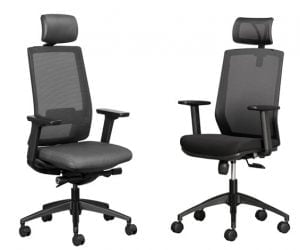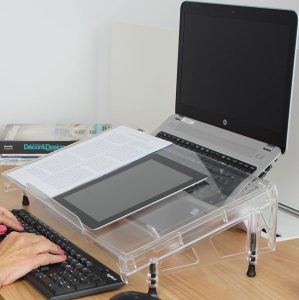
Why a fully adjustable office chair is important
We are all different, so when you buy a new office chair, look for one that has all the adjustability features.
Office workers spend more than 90% of their working hours sitting at their desks. According to the World Health Organization (WHO), a sedentary lifestyle is leading cause of disease and disability. Apart from the negative effects sitting has on the body, we sometimes become so engaged that we even neglect to breathe correctly which fatigues the brain and slows down the thinking process. Office workers can also experience eye discomfort and vision problems due to looking at their screens for long periods. How do you overcome the negative effects of sitting too long? What are the best exercises and stretches for office workers?
It is important to keep your body and mind healthy. Take the time to move and do office exercises and stretches for ALL parts of your body. In this article and set of videos, we will discuss the best exercises for office workers and even include some deep breathing techniques to improve your mood and reduce stress at work!
Sitting for long periods, and especially poor sitting habits, will cause bad posture. This results in additional stress on your spine, intervertebral discs, and muscles in your lower back, neck and shoulders. What actually happens when you sit?

The WHO and other researchers have found that excessive sitting can raise your risk of heart disease, diabetes, stroke, high blood pressure, and high cholesterol.
Office exercises and stretches, maintaining a good posture and understanding the importance of how to sit properly, are key to avoiding and managing stress at work. Exercise helps reduce the likelihood of job burnout and being tired at work.
In the following 8 videos we will show you some of the best exercises for office workers.
You don’t have to do them all – try them out and the select those that work best for you!

Stop exercises if you experience any pain or discomfort.
Consult your healthcare professional if pain or discomfort persists.
The muscles at the back of the neck commonly feel tight as they overwork to hold the head upright. A simple way to help prevent neck and shoulder pain associated with computer use, is to follow these simple neck and shoulder stretches that can easily be done in the office or at home.

With the other arm, pull your elbow into your chest until you feel a gentle stretch in your shoulder. Hold for 5 seconds.

Office workers that sit for long periods without any breaks or exercises, often experience some form of back pain. Regular exercises and stretches can strengthen the muscles that support your back, thereby reducing the risk of back pain. In addition, it is essential that your chair is correctly adjusted.
Tight hamstrings (the large muscles in the back of your thighs), is often as a result of too much sitting in the workplace.


According to an article published in NBC News, sitting for long periods can result in tight hips. This may decrease mobility of the hips and force other muscles (adductors, IT band, foot muscles, etc.), to overwork. Doing exercises and stretches to loosen up your hips is therefore important for office workers.
Our core connects every part of our body. Sitting for long periods weakens the core so it is essential to build its strength. Doing exercises and stretches for your core while you are in the office, is both quick and easy.


Working long hours at the computer every day can place serious strain on your fingers, hands, wrists and arms. Correctly setting up your workspace can prevent muscle strain and other injuries in your fingers, wrists, hands and arms.
Diaphragm or deep breathing is easy to learn. You can do it whenever and wherever you want to relax and reduce stress. Other benefits associated with deep breathing include reducing blood pressure, slowing down your heart rate and increasing oxygen in your blood which increases stamina and promotes healing.

Staring at a computer screen all day can put strain on your eyes. Poor lighting, glare on your screen, improper viewing distance and uncorrected vision problems are all factors that contribute to computer-related eyestrain. An incorrect viewing distance and vision problems often lead to a poor sitting posture.
Eye strain may result in work errors, headaches, blurred vision, dry eyes and neck and shoulder pain.


Stop exercises if you experience any pain or discomfort.
Consult your healthcare professional if pain or discomfort persists.
For your convenience, here is the complete video that includes all 8 of the above Vlogs.
All of these office exercises and stretches can easily be incorporated into your daily workday routine. Improve your mood and general wellbeing by doing these basic exercises at work every day!

We are all different, so when you buy a new office chair, look for one that has all the adjustability features.

One of the best ergonomic accessories you can get is a document holder.

Although the upfront cost of ergonomic office chairs may seem high, over their lifespan they are a low-cost and smart investment.


